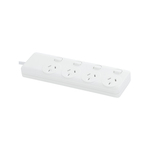Was on sale in February for $16, so for those holding out for a better deal, here it is!
wisepage has uploaded a deal with a 8-Outlet USB Powerboard (one word?), but these are individually-switched, if that means more to you. https://www.ozbargain.com.au/node/765178


FWIW, I have had 3 Arlec devices fail this week.
A 12 port powerboard.
A sensor for lights.
And a light with a sensor built in. Personally, I am going to steer clear of them from now on.